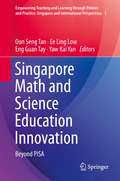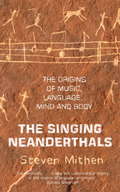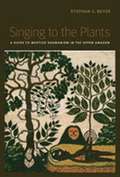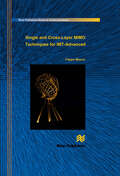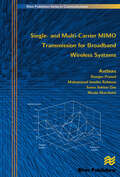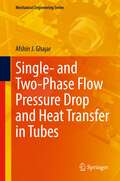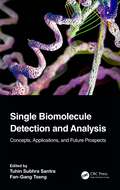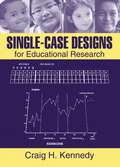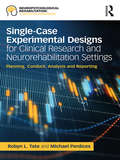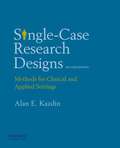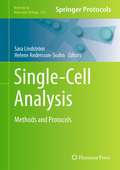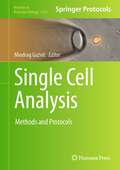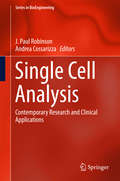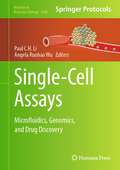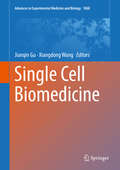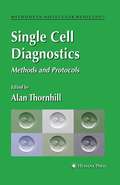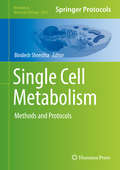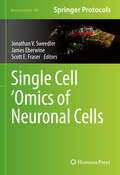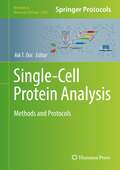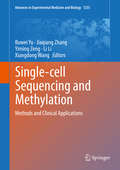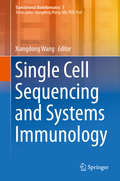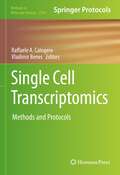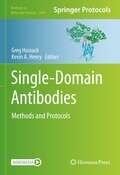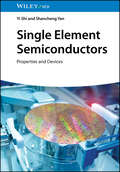- Table View
- List View
Singapore Math and Science Education Innovation: Beyond PISA (Empowering Teaching and Learning through Policies and Practice: Singapore and International Perspectives #1)
by Oon Seng Tan Ee Ling Low Eng Guan Tay Yaw Kai YanThis edited volume explores key areas of interests in Singapore math and science education including issues on teacher education, pedagogy, curriculum, assessment, teaching practices, applied learning, ecology of learning, talent grooming, culture of science and math, vocational education and STEM. It presents to policymakers and educators a clear picture of the education scene in Singapore and insights into the role of math and science education in helping the country excel beyond international studies such as PISA, the pedagogical and curricula advancements in math and science learning, and the research and practices that give Singaporean students the competitive edge in facing the uncertain and challenging landscape of the future.
The Singing Neanderthals: The Origins of Music, Language, Mind and Body
by Prof Steven MithenA fascinating and incisive examination of our language instinct from award-winning science writer Steven Mithen.Along with the concepts of consciousness and intelligence, our capacity for language sits right at the core of what makes us human. But while the evolutionary origins of language have provoked speculation and impassioned debate, music has been neglected if not ignored. Like language it is a universal feature of human culture, one that is a permanent fixture in our daily lives.In THE SINGING NEANDERTHALS, Steven Mithen redresses the balance, drawing on a huge range of sources, from neurological case studies through child psychology and the communication systems of non-human primates to the latest paleoarchaeological evidence.The result is a fascinating and provocative work and a succinct riposte to those, like Steven Pinker, who have dismissed music as a functionless and unimportant evolutionary byproduct.
The Singing Neanderthals: The Origins of Music, Language, Mind and Body
by Steven MithenA fascinating and incisive examination of our language instinct from award-winning science writer Steven Mithen.Along with the concepts of consciousness and intelligence, our capacity for language sits right at the core of what makes us human. But while the evolutionary origins of language have provoked speculation and impassioned debate, music has been neglected if not ignored. Like language it is a universal feature of human culture, one that is a permanent fixture in our daily lives.In THE SINGING NEANDERTHALS, Steven Mithen redresses the balance, drawing on a huge range of sources, from neurological case studies through child psychology and the communication systems of non-human primates to the latest paleoarchaeological evidence.The result is a fascinating and provocative work and a succinct riposte to those, like Steven Pinker, who have dismissed music as a functionless and unimportant evolutionary byproduct.
Singing To The Plants: A Guide To Mestizo Shamanism In The Upper Amazon
by Stephan V. BeyerIn the Upper Amazon, mestizos are the Spanish-speaking descendants of Hispanic colonizers and the indigenous peoples of the jungle. Some mestizos have migrated to Amazon towns and cities, such as Iquitos and Pucallpa; most remain in small villages. They have retained features of a folk Catholicism and traditional Hispanic medicine, and have incorporated much of the religious tradition of the Amazon, especially its healing, sorcery, shamanism, and the use of potent plant hallucinogens, including ayahuasca. The result is a uniquely eclectic shamanist culture that continues to fascinate outsiders with its brilliant visionary art. Ayahuasca shamanism is now part of global culture. Once the terrain of anthropologists, it is now the subject of novels and spiritual memoirs, while ayahuasca shamans perform their healing rituals in Ontario and Wisconsin. Singing to the Plants sets forth just what this shamanism is about--what happens at an ayahuasca healing ceremony, how the apprentice shaman forms a spiritual relationship with the healing plant spirits, how sorcerers inflict the harm that the shaman heals, and the ways that plants are used in healing, love magic, and sorcery.
Single and Cross-Layer Mimo Techniques for Imt-Advanced (River Publishers Series In Communications Ser.)
by Filippo MeucciIn the last two decades, the wireless arena has witnessed the emergence of an astonishing number of technologies which play a part in the definition of new wireless systems. Driven by the pressing capacity demand, the research community has developed several technological enablers. Fundamental technological building blocks that will be part of wireless systems in the near-future definitely include: Orthogonal Frequency Division Multiplexing (OFDM) modulation at the physical (PHY) layer, Multiple Input Multiple.Output (MIMO) systems, and a cross-layer (CL) stack design. While the benefits of OFDM have been recognized for several years, the real capacity improvement of MIMO antennae is still being debated today. As to the lastpoint, even if opportunities for CL have been pointed out for a long time, the impact on the actual legacy systems has not been noticeable, as investors are hesitant to implement the inherent design paradigm shift.Single and Cross-Layer MIMO Techniques for IMT-Advanced will present some advanced MIMO techniques where adaptivity, cross-layer approach, and MIMO antennae are analyzed together to show a deep impact on the sum-capacityachievable over the wireless link.The introduction presents the functional requirements for IMT-A candidate systems and the relation between IEEE802.16 and LTE wireless access networks. Then, in the first part, adaptive strategies are analyzedseparately at the PHY and Medium Access Control (MAC) layers. The second part presents an evolution of the previous approach, providing a cross-layer MIMO-ARQ protocol, where adaptive MIMO schemes, namely SpatialMultiplexing (SM) and STBC Alamouti, are used with ARQ protocol. A Multiple User (MU) network is served in DownLink (DL) with a Round Robin (RR) scheduler; the design is ready to include more advanced schedulers. The ARQstate machine at the MAC layer is aware of per-antenna ARQ. The interaction between the ARQ and the PHY layer, with a per-antenna ACK, allows resource exploitation to increase with per-antenna ACKs, shifting from MIMO Signal Processing Gain to MIMO Protocol Gain with no need for Channel State Information (CSI) feedback. The absence of CSI feedback at the PHY layer is an important characteristic of the proposedMIMO-ARQ cross-layer designs since MIMO CSI feedback (when feasible) drastically reduces the network efficiency.The added degrees of freedom offered by MIMO transmissions can make the difference if correctly exploited both at the physical and medium access layers, in particular for overcoming the problem of low MIMO channel ranks.The advantages of the paradigm shift from signal processing gain to protocol gain - together with the modifications to be applied at the classical protocol stack - are discussed in the final chapter.
Single- And Multi-Carrier Mimo Transmission for Broadband Wireless Systems (River Publishers Series In Information Science And Technology Ser.)
by Ramjee Prasad Muhammad Imadur Rahman Sekhar Suvra DasThe main focus of Single- and Multi-Carrier MIMO Transmission for Broadband Wireless Systems is to provide the basic understanding of the underlying techniques related to PHY-MAC design of future wireless systems. It includes basic concepts related to single- and multi-carrier transmissions together with MIMO techniques. Discussions related to different recent standards that use single- and multi-carrier transmissions are also explained.Single- and Multi-Carrier MIMO Transmission for Broadband Wireless Systems provides a comprehensive and holistic approach to the variety of technical solutions. Future system design would require these different technologies to work together, and not independently. Therefore, it is very important to analyze the effects and gains when they are put together in a unified platform. This is the prime focus of this book. Moreover, the authors include recent research results which are not yet published in another form. The book is intended to be used for lectures in graduate level courses at universities. PhD level students should also find it useful as this book will outline the fundamental concepts and design methods for PHY and MAC layers of future wireless systems. This book can also be used as a reference by engineers and developers in the industry as well as by researchers in academia. For professionals, system architects and managers who play a key role in the selection of a baseline system concept for future wireless standards, such as IMT-Advanced type architecture, the authors will include discussions, analysis and guidelines to highlight overall system level perspective.
Single- and Two-Phase Flow Pressure Drop and Heat Transfer in Tubes (Mechanical Engineering Series)
by Afshin J. GhajarThe book provides design engineers an elemental understanding of the variables that influence pressure drop and heat transfer in plain and micro-fin tubes to thermal systems using liquid single-phase flow in different industrial applications. It also provides design engineers using gas-liquid, two-phase flow in different industrial applications the necessary fundamentals of the two-phase flow variables. The author and his colleagues were the first to determine experimentally the very important relationship between inlet geometry and transition. On the basis of their results, they developed practical and easy to use correlations for the isothermal and non-isothermal friction factor (pressure drop) and heat transfer coefficient (Nusselt number) in the transition region as well as the laminar and turbulent flow regions for different inlet configurations and fin geometry. This work presented herein provides the thermal systems design engineer the necessary design tools. The author further presents a succinct review of the flow patterns, void fraction, pressure drop and non-boiling heat transfer phenomenon and recommends some of the well scrutinized modeling techniques.
Single Biomolecule Detection and Analysis: Concepts, Applications, and Future Prospects
by Tuhin Subhra Santra Fan-Gang TsengThis collection discusses various micro/nanodevice design and fabrication for single-biomolecules detection. It will be an ideal reference text for graduate students and professionals in diverse subject areas including materials science, biomedical engineering, chemical engineering, mechanical engineering, and nanoscience. This book- Discusses techniques of single-biomolecule detection, their advantages, limitations, and applications. Covers comprehensively several electrochemical detection techniques. Provides single-molecule separation, sensing, imaging, sequencing, and analysis in detail. Examines different types of cantilever-based biomolecule sensing, and its limitations. Single Biomolecule Detection and Analysis covers single-biomolecule detection and characterization using micro/nanotechnologies and micro/nanofluidic devices, electrical and magnetic detection technologies, microscopy and spectroscopy techniques, single biomolecule optical, and nanopore devices. The text covers key important biosensors-based detection, stochastic optical reconstruction microscopy-based detection, electrochemical detection, metabolic engineering of animal cells, single-molecule intracellular delivery and tracking, terahertz spectroscopy-based detection, total internal reflection fluorescence (TIFR) detection, and Fluorescence Correlation Spectroscopy (FCS) detection. The text will be useful for graduate students and professionals in diverse subject areas including materials science, biomedical engineering, chemical engineering, mechanical engineering, and nanoscience. Discussing chemical process, physical process, separation, sensing, imaging, sequencing, and analysis of single-molecule detection, this text will be useful for graduate students and professionals in diverse subject areas including materials science, biomedical engineering, chemical engineering, mechanical engineering, and nanoscience. It covers microscopy and spectroscopy techniques for single-biomolecule detection, analysis, and their biomedical engineering applications.
Single-Case Designs for Educational Research
by Craig H. KennedySingle-Case Designs for Educational Research provides up-to-date in-depth information about the use of single-case experimental designs in educational research across a range of educational settings and students. Appropriate for those pursuing advanced degrees in Education and Special Education.
Single-Case Experimental Designs for Clinical Research and Neurorehabilitation Settings: Planning, Conduct, Analysis and Reporting (Neuropsychological Rehabilitation: A Modular Handbook)
by Robyn Tate Michael PerdicesThis book is a practical resource designed for clinicians, researchers, and advanced students who wish to learn about single-case research designs. It covers the theoretical and methodological underpinnings of single-case designs, as well as their practical application in the clinical and research neurorehabilitation setting. The book briefly traces the history of single-case experimental designs (SCEDs); outlines important considerations in understanding and planning a scientifically rigorous single-case study, including internal and external validity; describes prototypical single-case designs (withdrawal-reversal designs and the medical N-of-1 trial, multiple-baseline designs, alternating-treatments designs, and changing-criterion designs) and required features to meet evidence standards, threats to internal validity, and strategies to address them; addresses data evaluation, covering visual analysis of graphed data, statistical techniques, and clinical significance; and provides a practical ten-step procedure for implementing single-case methods. Each chapter includes detailed illustrative examples from the neurorehabilitation literature. Novel features include: A focus on the neurorehabilitation setting, which is particularly suitable for single-case designs because of the complex and often unique presentation of many patients/clients. A practical approach to the planning, implementation, data analysis, and reporting of single-case designs. An appendix providing a detailed summary of many recently published SCEDs in representative domains in the neurorehabilitation field, covering basic and instrumental activities of daily living, challenging behaviours, disorders of communication and cognition, mood and emotional functions, and motor-sensory disabilities. It is valuable reading for clinicians and researchers in several disciplines working in rehabilitation, including clinical and neuropsychology, education, language and speech pathology, occupational therapy, and physical therapy. It is also an essential resource for advanced students in these fields who need a textbook for specialised courses on research methodology and use of single-case design in applied clinical and research settings.
Single-Case Research Designs: Methods for Clinical and Applied Settings
by Alan KazdinThe fact that professors continue to use the first edition of this book more than twenty years after it was published is a testament to the quality of information, organization, and narrative throughout the text. The possibility of a revision has professors excited that they can expose their students to a well-written, clear, and updated text that will reflect the current status of single-case research.
Single-Cell Analysis
by Helene Andersson-Svahn Sara LindströmToday, cells are commonly analyzed en masse, with thousands of cells per sample, yielding results on the average response of the cells. However, cellular heterogeneity implies that in order to learn more about cellular behaviour, it is important to study how individual cells respond, one by one. In Single-Cell Analysis: Methods and Protocols, experts in the field provide an update on the field of single-cell analysis wherein the latest findings and applications are described in detail. The methods described in this book include a few examples of conventional methods and several examples of miniaturized methods. Written in the highly successful Methods in Molecular BiologyTM series format, chapters include introductions to their respective topics, lists of the necessary materials and reagents, step-by-step, readily reproducible laboratory protocols, and key tips on troubleshooting and avoiding known pitfalls. Authoritative and accessible, Single-Cell Analysis: Methods and Protocols encourages readers to explore new ways of studying cells that may help lead to exciting new discoveries.
Single Cell Analysis: Methods and Protocols (Methods in Molecular Biology #2752)
by Miodrag GužvićThis volume explores the latest advancements and techniques used to study cell analysis, their capabilities, and the type of results that can be obtained. The chapters in this book cover topics such as FACS; fluorescence microscopy; organic spectroscopy such as MALDI; inorganic spectroscopy such as ICP-MS; and sequencing. Written in the highly successful Methods in Molecular Biology series format, chapters include introductions to their respective topics, lists of the necessary materials and reagents, step-by-step, readily reproducible laboratory protocols, and tips on troubleshooting and avoiding known pitfalls.Cutting-edge and practical, Single Cell Analysis: Methods and Protocols is a valuable tool for any researcher interested in learning more about this important and developing field.
Single Cell Analysis
by J. Paul Robinson Andrea CossarizzaThe resurgence of interest in high-resolution evaluation of single-cell properties has led to examining where current technology stands at the beginning of a new millennium. Engineers and scientists have produced significant advances in cytometric technologies in just the past few years. "Emerging Tools for Single-Cell Analysis: Advances in Optical Measurement Technologies" stresses the applications and theories behind some of these advances in cell measurement and cell- sorting technologies. Rapid assessment of the proper function of cells and molecular processes within cells is essential. To that end, new and varying technologies present important diagnostic and prognostic tools relevant to a variety of diseases. Future developments in miniaturization of electronics, micro- and nanomachines, and biomedical engineering are certain to impact cell biology. New analytical technologies are revolutionizing our ability to functionally characterize, isolate, and manipulate single cells. This timely book offers researchers and design engineers much-needed information as they further develop technologies for cell analysis. By comparing and contrasting various approaches, the authors explain how those technologies converge toward similar goals: evaluating the properties of cells and sorting cells on those properties using optically-based measurement systems. "Emerging Tools for Single-Cell Analysis" offers scientists and engineers a vision of the exciting possibilities that exist as new technologies are applied to single-cell analysis,
Single-Cell Assays: Microfluidics, Genomics, and Drug Discovery (Methods in Molecular Biology #2689)
by Paul C. H. Li Angela Ruohao WuThis detailed volume explores the use of single-cell assays in research for drug discovery, microfluidics, and more. The book delves into methodologies involving a variety of cell types and diseases, small molecules and biologics, as well as studies of the genome and transciptome. Written in the highly successful Methods in Molecular Biology series format, chapters include introductions to their respective topics, lists of the necessary materials and reagents, step-by-step and readily reproducible laboratory protocols, and tips on troubleshooting and avoiding known pitfalls. Authoritative and practical, Single-Cell Assays: Microfluidics, Genomics, and Drug Discovery serves to enable researchers to obtain a rapid overview in state-of-the-art microfluidic single-cell assays and an impression of what possibilities these assays offer to drug discovery.
Single Cell Biomedicine (Advances in Experimental Medicine and Biology #1068)
by Jianqin Gu Xiangdong WangThe book focuses on various detection targets applied in single cell studies, including tumor tissue cells, circulating tumor cells (CTCs), disseminated tumor cells (DTCs), circulating tumor DNA (ctDNA), cell-free DNA (cfDNA) and cancer stem cells (CSCs). It also discusses and compares detection methods using these detection targets in different fields to reveal single cell biomedical functions. The volume focuses not only on the methods already been established and validated, and also the methods newly developed. The book also highlights the importance and potential of single cell biomedicine in the development and validation of precision medicine strategies. It is useful for researchers and students in the field of cell biology, molecular medicine and precision medicine etc.
Single Cell Diagnostics
by Alan R. ThornhillThis book applies modern molecular diagnostic techniques to the analysis of single cells, small numbers of cells, or cell extracts. Emphasis is placed on non-invasive analysis of single cell metabolites and the direct analysis of RNA and DNA from single cells, with a focus on polymerase chain reaction and fluorescence in situ hybridization. In particular, this handbook is essential for practitioners providing care for couples seeking treatment for infertility.
Single Cell Metabolism: Methods and Protocols (Methods in Molecular Biology #2064)
by Bindesh ShresthaThis volume explores the latest techniques and workflow for the analysis of single cells metabolism. The chapters in this book cover topics such as the development of mass spectrometry-based single cell approaches, Pico-ESI-MS for single-cell metabolomics analysis; laser capture microdissection; ambient single cell metabolite profile (DESI and LAESI); and MALDI-MS methodology, quantum dots for quantitative cytology to study metabolic heterogeneity of single cells. Written in the highly successful Methods in Molecular Biology series format, the chapters consist of introductions to the topic, lists of the necessary materials and reagents, step-by-step guidelines, readily reproducible laboratory protocols, and tips on troubleshooting and avoiding known pitfalls. Comprehensive and authoritative, Single Cell Metabolism: Methods and Protocols is a valuable resource for any researcher and scientist interested in learning more about this field.
Single Cell ‘Omics of Neuronal Cells (Neuromethods #184)
by Jonathan V. Sweedler James Eberwine Scott E. FraserThis volume discusses the latest techniques used in the diverse fields of single cell ‘omics and covers topics such as quantifying the single cell transcriptome; isolation of cells in nanoliter volumes for single cell proteomics measurements by nano-LC-MS/MS; and single cell protein characterization by immunoblotting. A wide range of methodologies are highlighted, ranging from high-yield chemical amplification to mass spectrometry and nanotechnology for the analysis of the chemical constituents of cells. In the Neuromethods series style, chapters include both in-depth overviews, as well as detailed protocols that provide the key advice from specialists you need to get successful results in your laboratory. Cutting-edge and comprehensive, Single Cell ‘Omics of Neuronal Cells is a valuable resource for experienced and novice researchers interested in learning more about this field and its future developments.
Single-Cell Protein Analysis: Methods and Protocols (Methods in Molecular Biology #2386)
by Aik T. OoiThis detailed volume serves as a collection of methods for single-cell protein analysis, created by combining different protocols, taking advantage of new emerging technologies, and improving upon conventional methods to guide researchers aiming to perform protein analysis in single cells. Ranging from simple to complex, conventional to the most current technologies, these chapters offer readers the ability to choose the best suited methodologies for them, based on the sample type and the available technologies or equipment. Written for the highly successful Methods in Molecular Biology series, chapters include introductions to their respective topics, lists of the necessary materials and reagents, step-by-step, readily reproducible laboratory protocols, and tips on troubleshooting and avoiding known pitfalls. Authoritative and practical, Single-Cell Protein Analysis: Methods and Protocols aims to help researchers utilizing single-cell protein analysis in their studies as well to inspire the development of the next generation of improved protein analysis methods in single cells.
Single-cell Sequencing and Methylation: Methods and Clinical Applications (Advances in Experimental Medicine and Biology #1255)
by Buwei Yu Jiaqiang Zhang Yiming Zeng Li Li Xiangdong WangWith the rapid development of biotechnologies, single-cell sequencing has become an important tool for understanding the molecular mechanisms of diseases, defining cellular heterogeneities and characteristics, and identifying intercellular communications and single-cell-based biomarkers. Providing a clear overview of the clinical applications, the book presents state-of-the-art information on immune cell function, cancer progression, infection, and inflammation gained from single-cell DNA or RNA sequencing. Furthermore, it explores the role of target gene methylation in the pathogenesis of diseases, with a focus on respiratory cancer, infection and chronic diseases. As such it is a valuable resource for clinical researchers and physicians, allowing them to refresh their knowledge and improve early diagnosis and therapy for patients.
Single Cell Sequencing and Systems Immunology
by Xiangdong WangThe volume focuses on the genomics, proteomics, metabolomics, and bioinformatics of a single cell, especially lymphocytes and on understanding the molecular mechanisms of systems immunology. Based on the author's personal experience, it provides revealing insights into the potential applications, significance, workflow, comparison, future perspectives and challenges of single-cell sequencing for identifying and developing disease-specific biomarkers in order to understand the biological function, activation and dysfunction of single cells and lymphocytes and to explore their functional roles and responses to therapies. It also provides detailed information on individual subgroups of lymphocytes, including cell characters, function, surface markers, receptor function, intracellular signals and pathways, production of inflammatory mediators, nuclear receptors and factors, omics, sequencing, disease-specific biomarkers, bioinformatics, networks and dynamic networks, their role in disease and future prospects. Dr. Xiangdong Wang is a Professor of Medicine, Director of Shanghai Institute of Clinical Bioinformatics, Director of Fudan University Center for Clinical Bioinformatics, Director of the Biomedical Research Center of Zhongshan Hospital, Deputy Director of Shanghai Respiratory Research Institute, Shanghai, China.
Single Cell Transcriptomics: Methods and Protocols (Methods in Molecular Biology #2584)
by Raffaele A. Calogero Vladimir BenesThis volume provides up-to-date methods on single cell wet and bioinformatics protocols based on the researcher experiment requirements. Chapters detail basic analytical procedures, single-cell data QC, dimensionality reduction, clustering, cluster-specific features selection, RNA velocity, multi-modal data integration, and single cell RNA editing. Written in the highly successful Methods in Molecular Biology series format, chapters include introductions to their respective topics, lists of the necessary materials and reagents, step-by-step, readily reproducible laboratory protocols, and tips on troubleshooting and avoiding known pitfalls. Cutting-edge and comprehensive, Single Cell Transcriptomics: Methods and Protocols aims to be a valuable resource for all researchers interested in learning more about this important and developing field.
Single-Domain Antibodies: Methods and Protocols (Methods in Molecular Biology #2446)
by Greg Hussack Kevin A. HenryThis volume covers current and emerging techniques for studying single-domain antibodies (sdAbs). Chapters guide readers through the biology and immunology of sdAbs in camelids and sharks, isolation of sdAbs, protein engineering approaches to optimize the solubility, stability, valency and antigen binding affinity of sdAbs, and specialized applications of sdAbs. Written in the format of the highly successful Methods in Molecular Biology series, each chapter includes an introduction to the topic, lists necessary materials and reagents, includes tips on troubleshooting and known pitfalls, and step-by-step, readily reproducible protocols. Authoritative and cutting-edge, Single-Domain Antibodies: Methods and Protocols aims to be a useful, practical guide to help researchers further their studies in this field.
Single Element Semiconductors: Properties and Devices
by Yi Shi Shancheng YanComprehensive reference on the use of single-element semiconductor materials, such as carbon, silicon, and others, in modern electronic devices Single Element Semiconductors discusses the preparation, properties, and applications of single-element semiconductor materials in modern electronic devices. Special attention is paid to the nanostructures which show great potential in the fields of energy, electronics, and sensing due to their unique physicochemical properties. Written by a highly qualified team of researchers, Single Element Semiconductors includes information on: Properties and fabrication of carbon nanomaterials, germanium, borophene, stanene, arsenene, and antimoneneSynthesis, self-assembly, and in-plane epitaxy of horizontal silicon nanowiresBlue, black, and violet phosphorus and the controlled synthesis of tellurium nanomaterialsMost suitable applications for each element semiconductor, including in photodetectors, solar cells, batteries, biomedical sensors, and photocatalysis Single Element Semiconductors is an ideal reference for researchers and engineers seeking to advance the research and application development of single-element semiconductor materials.
